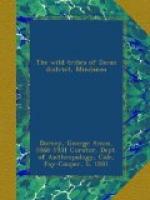The foregoing account shows that the Kagan and Tagakaolo living on the hemp plantations differ very little from their neighbors, whom we have previously described. It may be that an investigation, carried on in peaceful times, far back in the mountains, will show that more radical differences exist in the great body of the tribe.
V. ATA.
The people classed under this name are the least known of any of the wild inhabitants of Mindanao. They probably receive their name from the word atas which signifies “those up above” or “the dwellers in the uplands.” It does not appear that they form a single tribe, or that they are even of uniform type.
The writer did no intensive work with them, and the following notes make no pretense of being first-hand knowledge. I have drawn on all possible sources for this scanty information, but am mostly indebted to the letters and reports of the late Governor Bolton, who, without doubt, knew more of this people than any other white man.
I am thus compelled to make my descriptions vague; indeed, my one excuse for dealing with the Ata is to bring together such information as we possess in the hope that it may be of value to some other worker who may later take up the task of studying this little known people.
According to Governor Bolton, the Ata inhabit the regions west and northwest of Mt. Apo, the headwaters of the Davao river—north and west of the Guianga—as well as the headwaters of the Lasan, Tuganay, and Libagawan rivers. In all these regions they extend over the watershed, converging toward the center of the island at the headwaters of the Pulangi river.
It should be noted at the outset that the Eto or Ata, living between the Guianga and Bagobo, should not be included in this division.
In the region about Mt. Apo they are closely allied to the Obo and Tigdapaya,[1] while in the region adjoining the Guianga they have intermarried with that people and have adopted many of their customs as well as dress. On the headwaters of the Lasan river we are told that they are known as Dugbatang or Dugbatung; that they are a timid degenerate branch having no fixed habitations and very little clothing; they are small, with crispy hair, and often decorate their bodies with tattooed designs. About twenty miles up the Tuganay river Governor Bolton encountered a similar group of Ata whom he describes as being very wild. From the headwaters of this river he crossed over near to the source of the river Libagawan where he discovered a hitherto unknown people—the Tugauanum. These he believed were mixed Malay and Negrito, with crispy or curly hair and sharp features.
[1] See p. 128.
While in the central part of Mindanao, on the headwaters of the Pulangi river, the writer saw about fifty people known as Tugauanum who came over the mountains to trade. They were certainly of mixed ancestry, showing a distinct infusion of Negrito blood, and in other respects conforming to the description of Governor Bolton. Among articles of barter carried by them were the typical knives and hemp cloth of the west side of the Davao gulf region, showing that they are at least in the line of trade with the tribes we have already studied.




